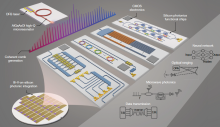
Microcombs have sparked a surge of applications over the past decade, ranging from
optical communications to metrology1–4. Despite their diverse deployment, most
microcomb-based systems rely on a large amount of bulky elements and equipment
to fulfil their desired functions, which is complicated, expensive and power
consuming. By contrast, foundry-based silicon photonics (SiPh) has had remarkable
success in providing versatile functionality in a scalable and low-cost manner5–7, but
its available chip-based light sources lack the capacity for parallelization, which limits
the scope of SiPh applications. Here we combine these two technologies by using a
power-efficient and operationally simple aluminium-gallium-arsenide-on-insulator
microcomb source to drive complementary metal–oxide–semiconductor SiPh
engines. We present two important chip-scale photonic systems for optical data
transmission and microwave photonics, respectively. A microcomb-based integrated
photonic data link is demonstrated, based on a pulse-amplitude four-level
modulation scheme with a two-terabit-per-second aggregate rate, and a highly
reconfigurable microwave photonic filter with a high level of integration is
constructed using a time-stretch approach. Such synergy of a microcomb and SiPh
integrated components is an essential step towards the next generation of fully
integrated photonic systems.